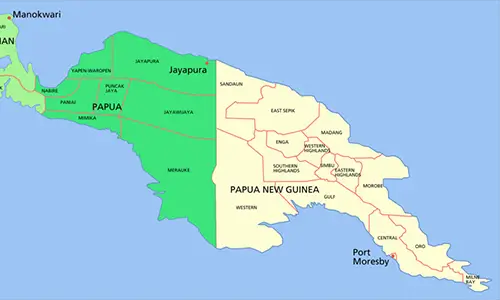Papua New Guinea is an island nation of the Pacific Island. It comprises many little islands and has a population of about 8 million. Once a British colony, the nation is still member of the Commonwealth and the Queen is the official HEAD OF State represented by a Governor nominated by the Papua New Guinean Parliament and appointed by the Queen.
FACT 1: Papua Guinea is part of Oceania. Oceania is not a continent but is a term used to refer to the islands of the Pacific Island. There are various definitions of the term Oceania. The most restricted definition is that of those islands that do not have a strong cultural and traditional relationship with mainland Asia. By this definition Australia and New Zealand not counted.
FACT 2: Papua New Guinea occupies the Eastern half of the island of New Guinea. New Guinea is the second largest island in the world. The island was divided in 1885. The western half became a German colony and the Eastern half a British colony. In 1902 the British half was transferred to Australia. Australian forces occupied it during World War I and continued to administer it till the nation was born in 1975.The western half of the island now is part of Indonesia.
FACT 3: The nation Papua New Guinea comprises the eastern half of New Guinea, the Bismarck Archipelago, the islands of Bougainville and Buka and a host of smaller islands and atolls. The capital city is Port Moresby.
FACT 4: The country falls within the Pacific Ring of Fire. It has many active volcanoes and is subject to earthquakes, mud slides and tsunamis. The town of Rabaul was destroyed twice (1937, 1994) by the volcano of the same name. In 1951, Mount Lamington erupted, killing 3,000 people. The island of Manam was abandoned after its volcano erupted in 2004.
FACT 5: The original inhabitants of the islands are called the Melanesians. Their presence on the island can be traced back to 40,000 years. Minute populations of Polynesians and Micronesians (people from other Pacific island areas) as well as immigrant people from Australia and China also live in Papua New Guinea today.
FACT 6: The official languages of the country are Tok Pisin, English and Hiri Motu. In addition 836 indigenous languages are spoken on the islands, accounting for 12 % of the world languages. However the number of people speaking these languages is often not more than a thousand.
FACT 7: Tok Pisin is a creole language. During the colonial era, the plantations owners and the workers spoke mutually unintelligible languages, leading to the development of the vernacular Tok Pisin. It is the most widely spoken language in Papua New Guinea, spoken and understood by almost all of the far flung little communities that comprise the nation. English is spoken by only 1 & and Hiri Motu by less than 2%.
FACT 8: For 65 million years the island nation has been isolated from main land Asia. This has led to the evolution of many unique biological species. There are no large mammals. This has assisted in the evolution of about 40 species of Birds of Paradise. The largest animals are the cassowary (a bird that does not fly) and the crocodile.
FACT 9: A land bridge once connected Papua New Guinea to Australia, so the two nations have some species in common. These include marsupials, tree kangaroos and echidnas.
FACT 10: The inhabitants have embraced various foreign religions, the most common being various denominations of Christianity. Some people are Baha’i and some Muslin. However the traditional sorcery and magic rituals are still widely practised.











Leave a Reply